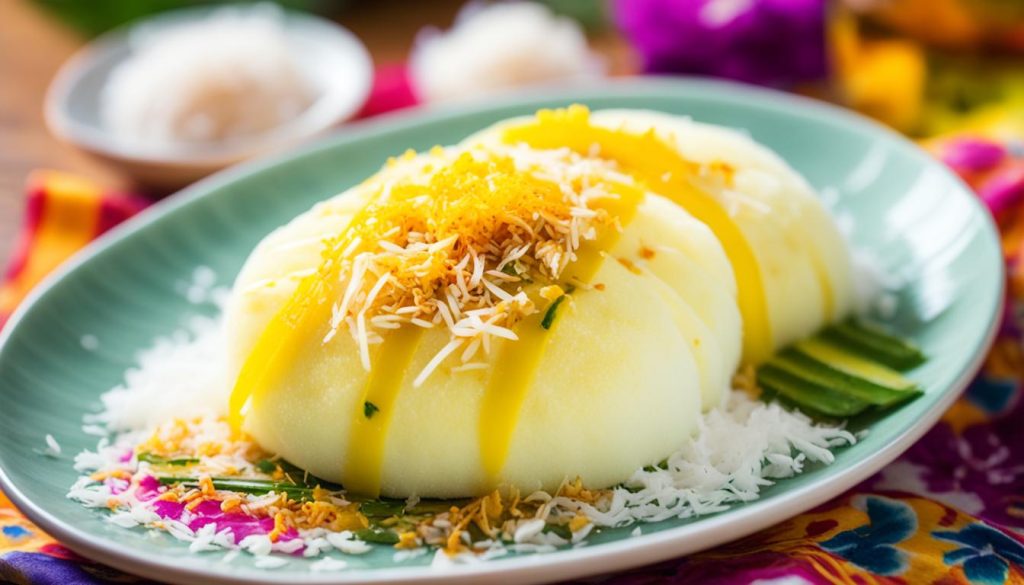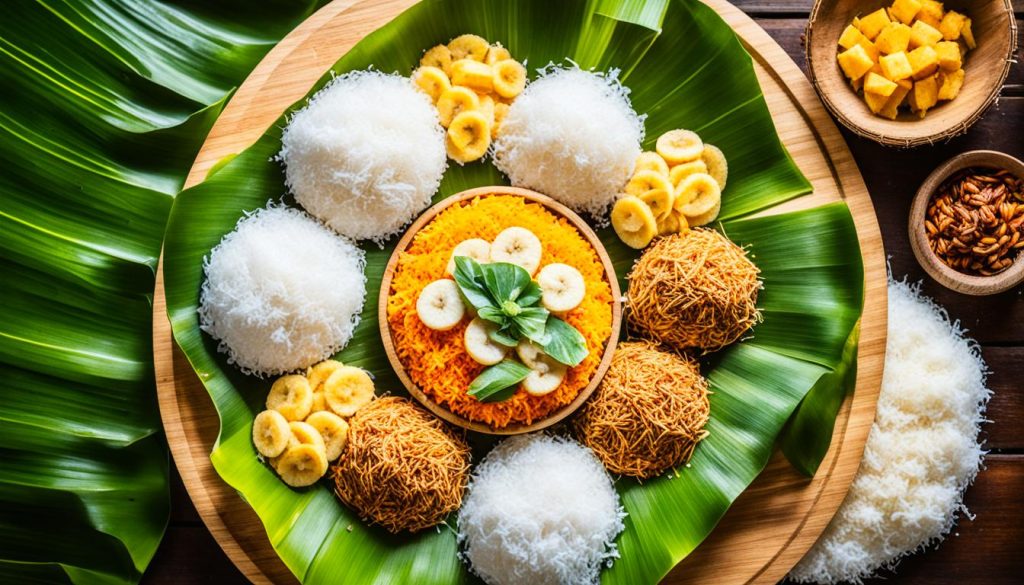Love Filipino food? Then you must know puto. These soft, small rice cakes are a favorite. They’re often eaten with pork blood stew (dinuguan) or Filipino noodles (pancit). So, what’s the story behind puto and how is it made?
Puto is a classic Filipino dish. It’s a steamed rice cake that’s been enjoyed for years. The original way to make it is by soaking and grinding rice to get “galapong.” But, today, many recipes use rice flour instead.
Key Takeaways
- Puto is a classic Filipino steamed rice cake that can be enjoyed as a snack or served with savory dishes.
- The traditional puto is made from a fermented rice batter called “galapong,” but modern recipes often use rice flour as a shortcut.
- Puto is a type of kakanin, which refers to a broad category of Filipino rice-based desserts and snacks.
- Using the right type of rice flour, not glutinous rice flour, is crucial for achieving the light and airy texture of puto.
- Puto can be enjoyed on its own or with a variety of sweet and savory toppings, making it a versatile and beloved Filipino delicacy.
What is Puto?
Puto is a small, fluffy, and slightly sweet steamed rice cake. It’s loved in the Philippines as a special treat. This snack falls under the kakanin category, which are rice-based desserts and snacks. It’s made by soaking and grinding rice grains into a batter known as “galapong.”
This batter is then steamed in molds or on banana-lined bamboo trays.
Traditional Puto Recipe
The traditional way to make puto starts with soaking and grinding rice grains. They turn into a fermented batter, or galapong. Then, this galapong is steamed in molds or on banana leaves.
This method gives puto its unique light and spongy texture. Also, the fermentation process adds a special tangy taste to it.
Ingredients Used in Modern Puto
Modern puto recipes take a convenient route, using rice flour. This quickens the process for bakers and home chefs. It means you don’t have to wait for the batter to ferment.
Rice flour, when combined with baking powder, still gives puto its classic light and fluffy texture. So, the taste and style remain, even without the long fermentation.
Why Puto is a Filipino Classic
Puto has a long history and is key in Filipino culture as a snack and dessert. The word “puto” comes from the Malay word “puttu,” which means “portioned.” This shows why puto cakes are usually small and easy to eat.
Origin of the Word “Puto”
“Puto” comes from the Malay word “puttu,” which means “portioned.” Its name fits well since these cakes are small and perfect for a quick bite.
Puto as a Type of Kakanin
Puto is part of a larger group of Filipino desserts called “kakanin.” Kakanin features various rice-based treats, adding to the sweet and savory mix. This makes puto not just a snack, but a part of Filipino food culture and tradition.

The Importance of Using Rice Flour
The kind of flour you use is key in making great puto. Regular rice flour is best for the light, airy qualities of puto. The preferred choice is regular rice flour, not the sticky kind.
Difference Between Rice Flour and Glutinous Rice Flour
Rice flour and glutinous rice flour each bring something unique. Regular rice flour comes from long or short grain rice and has less starch. This makes the puto softer when steamed. Glutinous rice flour, from sticky rice, is full of amylopectin starch. It makes puto chewier, denser, and stickier.
Tips for Sifting Rice Flour
Sifting rice flour is a must for puto’s airy texture. It makes the flour light and fluffy, ensuring a smooth batter. This prevents any clumps, making your puto light and soft.
What is puto, and how do you make it?
Preparing the Batter
To make puto, start by whisking eggs with milk and sometimes coconut milk. Then, add in rice flour and baking powder, which have been sifted together. Mix them gently until you get a smooth batter without any lumps.
Steaming Process
After making the batter, it’s time to steam the puto. You can use molds or banana-lined bamboo trays. Carefully pour the batter in, ensuring there’s space for it to grow while steaming. Then, you steam them until they’re soft, fluffy, and a bit see-through on top.
Serving and Storing Puto
Puto is at its best right after steaming. It’s light and fluffy. These Filipino rice cakes are perfect as a snack or with meals like dinuguan (pork blood stew) or pancit (noodles). Top your puto with cheese, salted eggs, or butter for extra taste.
Proper Storage Methods
While fresh puto is preferred, you can save some for later. Put leftovers in an airtight container at room temperature. Don’t refrigerate them, as it changes their texture. You can also freeze puto for up to 2 months. Reheat frozen puto in a steamer or oven. They’ll be warm and soft like fresh.

Puto Flavor Variations
Traditional puto comes with a delicate, slightly sweet taste. But there are so many ways to enjoy this Filipino treat beyond its classic taste. Puto can be made with different toppings and flavors, appealing to a wide range of people.
Sweet Puto Toppings
Puto lovers with a sweet tooth can enjoy many fun toppings. Shredded coconut adds a nice crunch and sweetness. Ube paste, made from purple yam, brings a rich, purple color and a nutty taste.
Or, try adding fruit jam for a pop of fruity flavor. These toppings make puto even more delicious.
Savory Puto Toppings
Puto isn’t just for those who like sweets. It can turn into a savory snack too. Melted cheese gives it a creamy, salty flavor. Salted eggs are also great, adding a nice savory contrast.
If you prefer something meaty, try it with tocino or longganisa. These add a yummy, smoky flavor to the puto cake.
Puto as a Complementary Dish
Puto is more than just a snack or dessert. It’s light and fluffy, with a hint of sweetness. That makes it perfect with many savory Filipino dishes. It’s often served with dishes like dinuguan (pork blood stew) and pancit. These dishes are saucy or rich, creating a perfect mix of flavors.
Puto’s softness balances the strong tastes of these Filipino dishes. The soft puto and strong main dishes work well together. This creates a great eating experience, making all the flavors stand out.
Adding puto to your meal can make it even better. This is true for both traditional Filipino meals and new food experiments. Its flexibility is why it’s a key item in Filipino cooking. It can work with many dishes, bringing joy to your taste buds.
Conclusion
Puto is a beloved Filipino treat that has been around for ages. It has changed over time. Now, it’s made with new ingredients and flavors. It is enjoyed by many as a snack or with meals. It’s light, airy, and has just the right amount of sweetness.
Learning about puto’s history and how it’s made, anyone can cook it at home. This lets you share this tasty treat with your loved ones. It’s a way to honor the flavors and culture of the Philippines.
Joining the puto journey means experiencing Filipino tradition and new ideas. It brings joy and a deeper connection to Filipino culture. Making and enjoying puto can become a special part of your family’s meals and cultural understanding.


